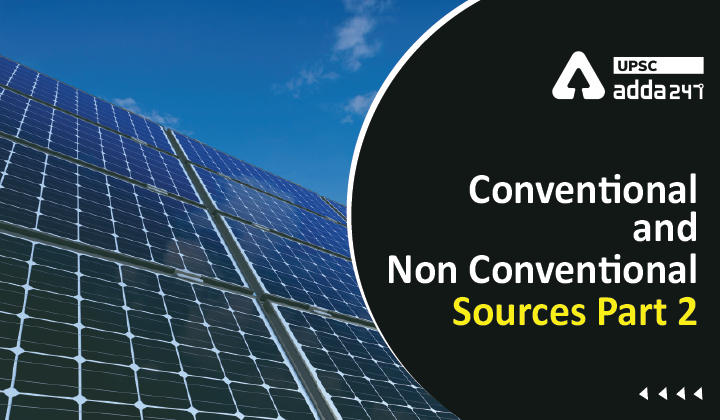Table of Contents
Conventional and Non-Conventional Sources of Energy
In our previous article, we discussed about the conventional sources of energy. In this article, we will discuss about the non-conventional sources of energy.
Non-conventional sources of energy
- The sources of energy which are being produced continuously in nature and are in exhaustible are called renewable sources of energy (or) non-conventional energy.
- These sources of energy do not cause environmental pollution and are, therefore, environmental-friendly sources of energy.
- Examples of non-conventional sources of energy: tidal energy, wind energy, hydel energy, solar energy, and geothermal energy.
Different types of non-conventional sources of energy
Solar energy
- Solar energy is the energy generated by the sunlight.
- The potential of solar energy is 178 billion MW which is about 20,000 times the world’s demand.
- It is one of the cleanest sources of energy, and has the most scope amongst the other renewable energy sources.
- Solar panels are made of semiconductive materials known as photovoltaic cells. These solar panels are capable of converting light to electricity.
- Solar panels are being used in households as a primary source of electricity. They are also used commercially in solar farms, which contain hundreds and thousands of solar panels.
- Since India is a sub-tropical country, it has immense potential to harness the solar energy.
- Government of India is also promoting the use of solar energy through schemes like National Solar Mission, PM KUSUM etc.
Wind energy
- Wind is caused due to two reasons:
- Absorption of solar energy on the earth’s surface and in the atmosphere.
- Rotation of the earth about its axis and its motion around the Sun.
- The energy that is generated by harnessing the power of wind is called wind energy.
- Wind mill is used to convert the kinetic energy of moving air into mechanical energy that can be used either directly to run a machine or to run the generator to produce electricity.
- The electricity produced by the wind turbines is directly proportional to the cube of the wind speed.
- India is the second largest country in the generation of wind power.
Tidal energy
- Tides are generated majorly due to the gravitational attraction between the earth and the Moon.
- Tidal energy is those energy that is generated by exploiting the tidal waves of the sea.
- In a tidal power station, water at high tides is first trapped in an artificial basin and then allowed to escape at low tides.
- The escaping water is used to drive water turbines, which in turn drive electrical generators
- This source of energy is yet to be tapped due to the lack of cost-effective technology.
Hydropower energy
- Energy that can be used to generate electricity by using natural or artificial flow of water are called hydropower energy.
- The most popular type of hydropower energy is hydroelectric dams and reservoirs. Example: Bhakra Nangal Project and Damodar Valley Project.
- Hydroelectric dams are built at lower elevation where rivers have a decent flow of water.
- The natural flow of the river is then used to move the turbines that are connected to generators.
- Rotation of turbines produces electricity, which is stored and then later transported for consumption.
Geothermal energy
- Geo thermal energy is energy coming out of the molten interior of the earth towards the surface.
- The word geothermal comes from the Greek words geo (earth) and therme (heat).
- Wells are drilled to trap steam which powers electrical generators.
- Steam is naturally produced from underground water, which gets heated due to very high temperature in that region.
Read UPSC favourite topics





 TSPSC Group 1 Question Paper 2024, Downl...
TSPSC Group 1 Question Paper 2024, Downl...
 TSPSC Group 1 Answer key 2024 Out, Downl...
TSPSC Group 1 Answer key 2024 Out, Downl...
 UPSC Prelims 2024 Question Paper, Downlo...
UPSC Prelims 2024 Question Paper, Downlo...
